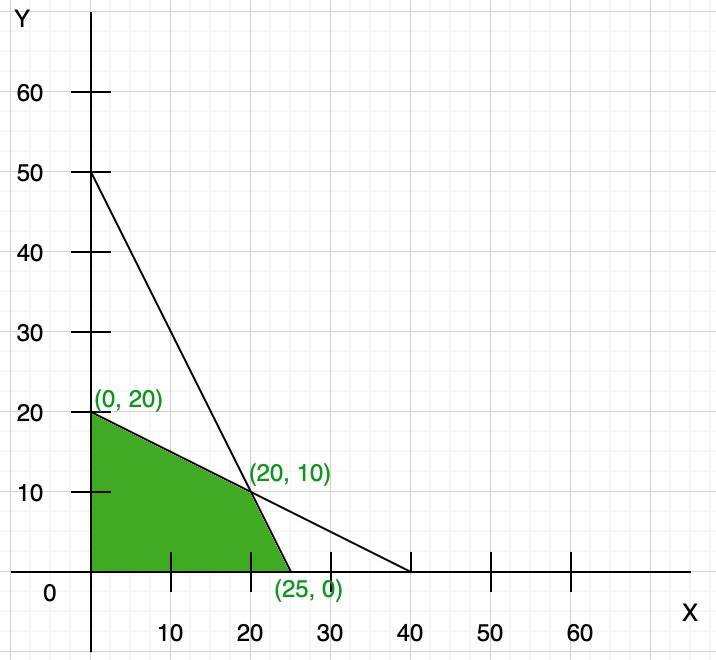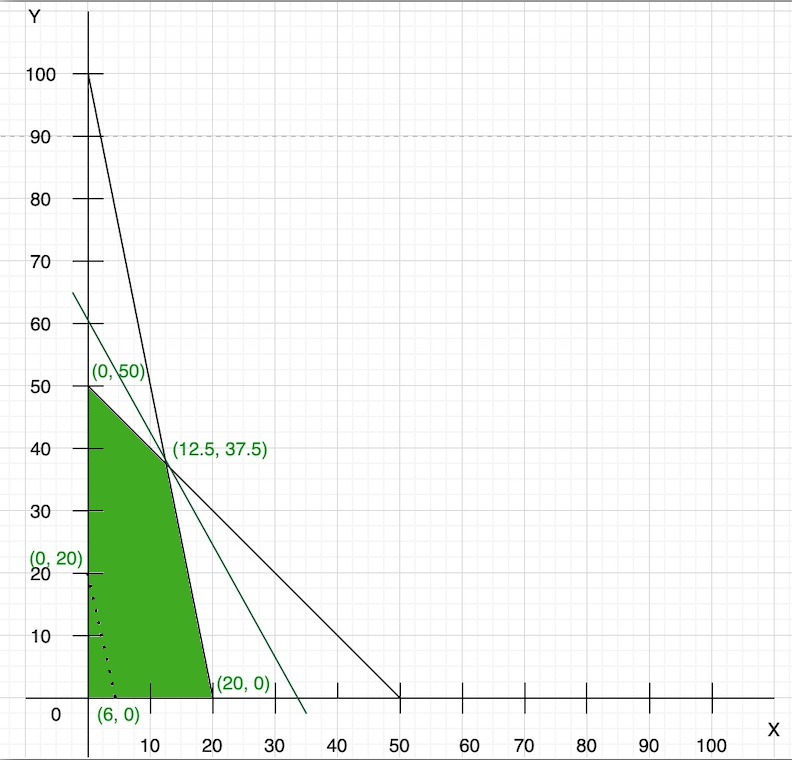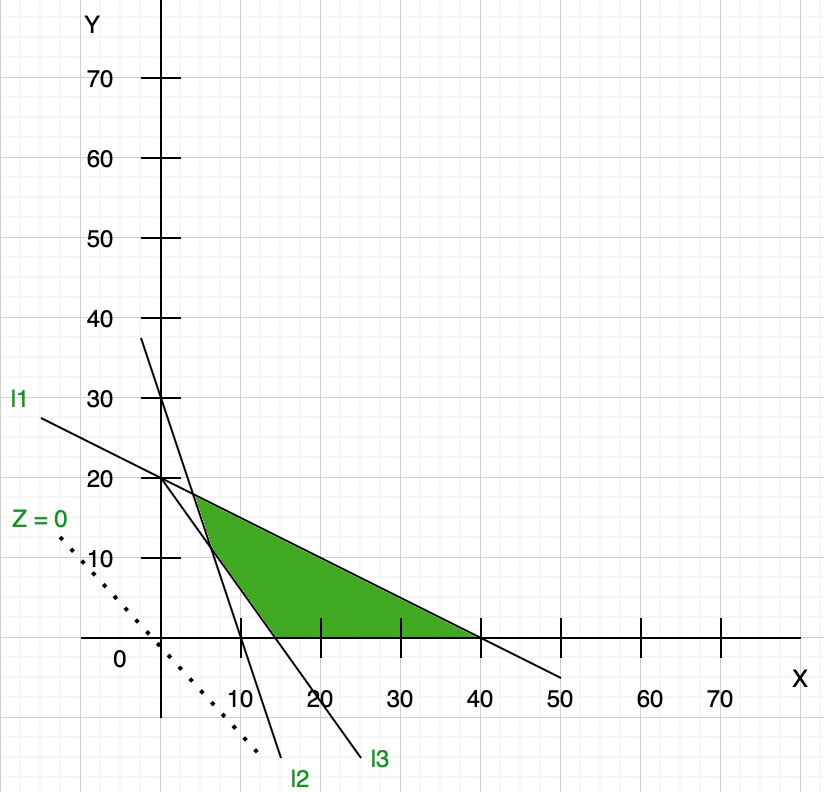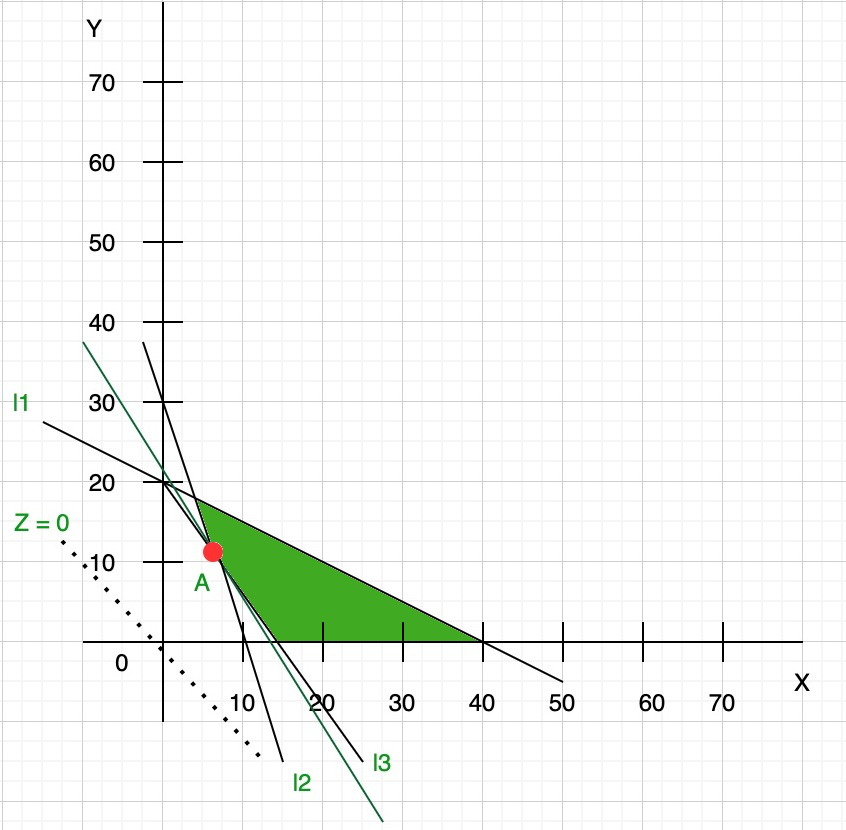线性编程是优化问题的最简单方法。通过这种方法,我们可以将现实世界中的问题公式化为数学模型。我们可以在不同部门中使用线性编程来解决各种各样的问题,但是它通常用于必须最大化利润,最小化成本或最小化资源使用的问题。
线性规划问题的类型
基于线性规划的问题主要有三种。这些如下:
制造问题:在这种类型的问题中,一些约束(例如人力,输出单位/小时,机器小时数)以线性方程的形式给出。而且,我们必须找到一种最佳解决方案,以实现最大的利润或最小的成本。
饮食问题:这类问题通常很容易理解,并且变数较少。我们在此类问题中的主要目标是最大程度地减少饮食成本,并必须使饮食中的每种成分的含量保持最少。
运输问题:在这些问题中,我们必须通过选择最短的路线/最佳路径来找到最便宜的运输方式。
线性编程问题中一些常用的术语是:
目标函数: Z = ax + by形式的直接函数(其中a和b为常数,被缩小或放大)称为目标函数。例如,如果Z = 10x + 7y。变量x和y称为决策变量。
约束:应用于线性不等式的约束称为约束。
- 非负约束:x> 0,y> 0,等等。
- 一般约束:x + y> 40,2x + 9y≥40等
优化问题:寻求最大化或最小化线性不平等问题的变量的问题称为优化问题。
可行区域:由所有给定问题(包括非负(x≥0,y≥0)约束)确定的公共区域称为问题的可行区域(或求解区域)。除可行区域以外的区域称为不可行区域。
可行的解决方案:边界区域内或边界上的这些点表示问题的可行解决方案。方案之外的任何点都称为不可行的解决方案。
最佳(最可行)解决方案:新兴地区中提供正确数量(最大或最小)目标函数的任何点都称为最佳解决方案。
线性规划问题定理
定理1:让我们认为Y是线性规划问题的可行区域(凸多边形),即Y = ax +(目标函数)。因此,当Y具有最佳值(最大值或最小值)时,其中x和y受到线性不等式描述的约束,则该最佳值出现在可行区域的拐角点(即顶点)上。
定理2:让我们认为Y是线性规划问题的可行区域,即Y = ax + by(目标函数)。如果X是有界的,则目标函数Y在X上同时具有最大值和最小值,并且每个值都出现在X的拐角处。
笔记:
- 如果必须找到最大输出,则必须考虑所有方程式的最内层相交点。
- 如果必须找到最小输出,则考虑所有方程式的最外面的相交点。
- 如果线性不等式没有共同点,那么就没有可行的解决方案。
线性规划问题的图形解决方案
我们可以使用两种不同的方法来解决线性规划问题:
- 角点
- 等成本法
角点
要使用拐角点方法解决问题,您需要执行以下步骤:
步骤1:根据给定的问题创建数学公式。如果没有给出。
步骤2:现在使用给定的约束绘制图形并找到可行的区域。
第3步:找到从第2步获得的可行区域(顶点)的坐标。
步骤4:现在在可行区域的每个拐角点评估目标函数。假设N和n表示这些点的最大值和最小值。
步骤5:如果可行区域是有界的,则N和n是目标函数的最大值和最小值。或者,如果可行区域是无界的,则:
- 如果开半计划是由斧头+乘以> N,则N是目标函数的最大值,它与可行区域没有共同点。否则,目标函数将无解。
- 如果开放式半计划由ax +通过
例子:
问题1.以图形方式解决给定的线性规划问题:
最大化:Z = 8x + y
约束是:
x + y≤40,
2x + y≤60,
x≥0,y≥0
解决方案:
Step 1: Constraints are :
x + y ≤ 40,
2x + y ≤ 60,
x ≥ 0, y ≥ 0
Step 2: Draw the graph using these constraints.

Here both the constraints are less than or equal to, so they satisfy the below region (towards origin). You can find the vertex of feasible region by graph, or you can calculate using the given constraints:
x + y = 40 …(i)
2x + y = 60 …(ii)
Now multiply eq(i) by 2 and then subtract both eq(i) and (ii), we get
y = 20
Now put the value of y in any of the equations, we get
x = 20
So the third point of the feasible region is (20, 20)
Step 3: To find the maximum value of Z = 8x + y. Compare each intersection point of the graph to find the maximum value
| Points | Z = 8x + y |
| (0, 0) | 0 |
| (0, 40) | 40 |
| (20, 20) | 180 |
| (30, 0) | 240 |
So the maximum value of Z = 240 at point x = 30, y = 0.
问题2:一种蛋糕需要200克面粉和25克脂肪,另一种蛋糕需要100克面粉和50克脂肪。找出5公斤面粉和1公斤可以制成的最大蛋糕数量假设制作蛋糕时所用的其他成分不短缺,则添加一定数量的脂肪。
解决方案:
Step 1: Create a table like this for easy understanding (not necessary).
| Floor(g) | Fat(g) | |
| Cake of first kind (x) | 200 | 25 |
| Cake of second kind (y) | 100 | 50 |
| Availability | 5000 | 1000 |
Step 2: Create linear equation using inequality
- 200x + 100y ≤ 5000 or 2x + y ≤ 50
- 25x + 50y ≤ 1000 or x + 2y ≤ 40
- Also, x > 0 and y > 0
Step 3: Create a graph using the inequality (remember only to take positive x and y-axis)

Step 4: To find the maximum number of cakes (Z) = x + y. Compare each intersection point of the graph to find the maximum number of cakes that can be baked.
| x | y | Z(x+y) |
| 0 | 20 | 20 |
| 20 | 10 | 30 |
| 25 | 0 | 25 |
Clearly, Z is maximum at co-ordinate (20, 10). So the maximum number of cakes that can be baked is Z = 20 + 10 = 30.
等成本法
术语“等成本法”或“等利润法”是指与同一行上任何其他组合产生相同成本/利润的点的组合。这是通过绘制平行于方程斜率的线来完成的。
要使用等成本法解决问题,您需要执行以下步骤:
步骤1:根据给定的问题创建数学公式。如果没有给出。
第2步:现在使用给定的约束绘制图形并找到可行的区域。
步骤3:现在找到从步骤2得到的可行区域的坐标。
步骤4:找到Z(目标函数)的便利值,并画出该目标函数的线。
步骤5:如果目标函数是最大类型,则画一条与目标函数线平行的线,该线离原点最远,并且到可行区域只有一个公共点。或者,如果目标函数是最小类型,则绘制一条与目标函数线平行的线,并且该线离原点最近,并且在可行区域内至少有一个公共点。
步骤6:现在获得在步骤5中找到的公共点的坐标。现在,该点用于找到最优解和目标函数的值。
例子:
问题1.以图形方式解决给定的线性规划问题:
最大化:Z = 50x + 15y
约束是:
5x + y≤100,
x + y≤50,
x≥0,y≥0
解决方案:
Given:
5x + y ≤ 100,
x + y ≤ 50,
x ≥ 0, y ≥ 0
Step 1: Finding points
We can also write as
5x + y = 100 ….(i)
x + y = 50 ….(ii)
Now we find the points
so we take eq(i), now in this equation
When x = 0, y = 100
and when y = 0, x = 20
So, points are (0, 100) and (20, 0)
Similarly, in eq(ii)
When x = 0, y = 50
When y = 0, x = 50
So, points are (0, 50) and (50, 0)
Step 2: Now plot these points in the graph and find the feasible region.

Step 3: Now we find the convenient value of Z(objective function)
So, to find the convenient value of Z, we have to take the lcm of coefficient of 50x + 15y, i.e., 150. So, the value of Z is the multiple of 150, i.e., 300. Hence,
50x + 15y = 300
Now we find the points
Put x = 0, y = 20
Put y = 0, x = 6
draw the line of this objective function on the graph:

Step 4: As we know that the objective function is maximum type then we draw a line which is parallel to the objective function line and farthest from the origin and only has one common point to the feasible region.

Step 5: We have a common point that is (12.5, 37.5) with the feasible region. So, now we find the optimal solution of the objective function:
Z = 50x + 15y
Z = 50(12.5) + 15(37.5)
Z = 625 + 562.5
Z = 1187
问题2:以图形方式解决给定的线性规划问题:
最小化:Z = 20x + 10y
约束是:
x + 2y≤40,
3x + y≥30,
4x + 3y≥60,
x≥0,y≥0
解决方案:
Given:
x + 2y ≤ 40,
3x + y ≥ 30,
4x + 3y ≥ 60,
x ≥ 0, y ≥ 0
Step 1: Finding points
We can also write as
l1 = x + 2y = 40 ….(i)
l2 = 3x + y = 30 ….(ii)
l3 = 4x + 3y = 60 ….(iii)
Now we find the points
So we take eq(i), now in this equation
When x = 0, y = 20
and when y = 0, x = 40
So, points are (0, 20) and (40, 0)
Similarly, in eq(ii)
When x = 0, y = 30
When y = 0, x = 10
So, points are (0, 30) and (10, 0)
Similarly, in eq(iii)
When x = 0, y = 20
When y = 0, x = 15
So, points are (0, 20) and (15, 0)
Step 2: Now plot these points in the graph and find the feasible region.

Step 3: Now we find the convenient value of Z(objective function)
So let us assume z = 0
20x + 10y = 0
x = -1/2y
draw the line of this objective function on the graph:

Step 4: As we know that the objective function is minimum type then we draw a line which is parallel to the objective function line and nearest from the origin and has at least one common point to the feasible region.

This parallel line touch the feasible region at point A. So now we find the coordinates of point A:
As you can see from the graph at point A l2 and l3 line intersect so we find the coordinate of point A by solving these equations:
l2 = 3x + y = 30 ….(iv)
l3 = 4x + 3y = 60 ….(v)
Now multiply eq(iv) with 4 and eq(v) with 3, we get
12x + 4y = 120
12x + 9y = 180
Now subtract both the equation we get coordinates (6, 12)
Step 5: We have a common point that is (6, 12) with the feasible region. So, now we find the optimal solution of the objective function:
Z = 20x + 10y
Z = 20(6) + 10(12)
Z = 120 + 120
Z = 240